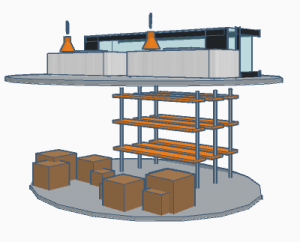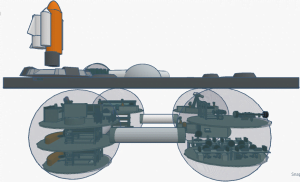Moon Camp Explorers Gallery 2020-2021
In Moon Camp Explorers each team’s mission is to 3D design a complete Moon Camp using Tinkercad. They also have to explain how they will use local resources, protect astronauts from the dangerous of space and describe the living and working facilities.
Team: The UCL Explorers
UCL Academy London United Kingdom 13
External link for 3d
|
Project description
We named our moon camp Sharman to commemorate Helen Sharman, who was the first British astronaut, the first Western European woman in space, and the first woman aboard the Russian space station Mir. As Britain was not part of ESA, Sharman’s expedition was in partnership with the Soviets and funded through a private group. Like in the development of Covid vaccines, Sharman represents how combining international cooperation, public initiatives, and private enterprise can achieve incredible goals. We designed our base to sustain 4 people in a 6-month rotation. Half the crew will rotate out every 3 months to transfer skills between old and new crew members. The base is self-sufficient, with the air and life-support systems being completely independent. This computer control eliminates the majority of human error and ensures the astronauts are safe and secure. Our camp is a hub/spoke design, this ensures the safety and security of our astronauts by closing off parts of the base if a problem occurs allowing it to continue to function. One of our primary goals is to investigate the possibility of growing plants using the lunar regolith to create a sustainable world for all of humankind. |
|||
|
Where do you want to build your Moon Camp?
Close to the Lunar Poles Why did you choose this location?
We will place the moon camp near the South Lunar Pole for three reasons, solar illumination, water reservoir availability, and proximity to lunar lava tubes. The South Lunar Pole is home to the Shackleton crater. It is under permanent solar illumination, which provides our lunar base energy. Also, there are sizeable underground water concentrations near the Lunar Pole, eliminating the need for transporting water from Earth. Finally, the location is adjacent to lunar lava tubes, which form when erupting lava hardens. This minimises the amount of heavy equipment we need because the tubes provide non-invasive access to the moon’s underground. How do you plan to build your Moon Camp? Which materials would you use?
We will build our moon camp using sustainable materials, innovative structures, and inventive transport. Our lunar base would be situated underground to protect against micrometeorites; the lunar lava tubes will provide easy access and diminish the need for drilling. We will make the foundation from lunarcrete, which is concrete that uses lunar regolith (a fine powdery soil), thereby reducing materials needed from Earth. Before our journey to the moon, we will send an uncrewed rocket containing all of the supplies necessary to build our base. The rocket will be dismantled and reused for construction materials such as titanium and aluminium. Explain how your Moon Camp will provide the astronauts with:
|
|||
|
Water
|
Food
|
Electricity
|
Air
|
|
We will provide water in two ways: use of underground reservoirs and filtration. Experts suggest that around 600 million metric tons of water ice are on the moon; this water ice is in permanently shadowed craters near the poles. Similar to the system implemented on the ISS, we would collect and filter condensation, sweat, and urine. This method combined with the water ice will be sufficient in supplying our base. |
We will provide food in two ways: controlled farming and sustainable practices. This food will be grown through tiered farming, which eliminates soil use. Instead, it uses reusable cloth made from recycled plastic. It also reduces water by 95%. We will use reusable and resealable packaging to minimise storage required and environmental impact. To ensure water supplies, we will collect condensation from our tiered farm. Our food will be a well-balanced diet comprised of plants and insects. Insects, such as grasshoppers, are high in protein, and others, like bees, will pollinate the plants we are growing and create honey. |
We will generate our power from solar illumination, biomass, and Helium 3. Solar illumination bathes the South Lunar Pole in light; by using photovoltaic solar panels, we will provide a steady energy source. Biomass is organic materials such as plants or animals that are used as fuel. We will use our excess food waste to create biomass and then use thermal or biochemical conversion to make it more efficient. Helium 3 is an element thought to provide safe and efficient nuclear energy without producing waste. While Helium 3 is scarce on Earth, there are significant quantities on the moon. |
We will provide air in three ways, water electrolysis, regular supply trips, and extracting nitrogen from our excrement. Water electrolysis is the process that splits water into hydrogen and oxygen. To simulate the earth‘s environment, we will combine oxygen with other gases to ensure a spark does not set the base aflame. There will have to be regular uncrewed trips to provide the gases and extra oxygen to the lunar base. We will also conduct experiments to revitalise the lunar regolith in hopes to create a habitable atmosphere. |
|
Describe a day on the Moon for one of your Moon Camp astronauts
The astronauts’ schedule will be dominated by three focus areas, physical and mental health, maintenance and experiments, and communications. The astronauts’ day will start at 06:00 GMT with a thirty-minute preliminary check of the base, followed by breakfast, which will finish at 7:00, followed by a thirty-minute call from Earth. Due to the reduced gravity, astronauts will exercise for an hour a day to maintain muscle mass. This will be from 7:30 until 8:30. The astronauts will then perform Moon Camp maintenance and complete their individual tasks for four hours. At 12:30, there will be lunch until 13:30. After this, astronauts will carry out Helium-3 testing and complete tests sent from Earth for four hours. These could include tests from schools to support mentoring of students. We would also have two hours every day for personal time, calling family, reading a book or meditating. As we have seen with COVID-19, being isolated from the rest of the world has detrimental effects on a person’s mental health. After the allotted free time, there will be a thirty-minute group assessment of the day until 20:00. Dinner then follows for an hour, after which the astronauts sleep for nine hours, ready for the next day’s activities. We would also reserve Sunday as a free day and have Saturday as a cleaning day. The astronauts can alter this schedule depending on their religious or personal observations. |
|||









